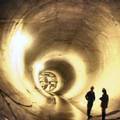完工後可處理暴雨挾帶污水 兼具防洪治污功能
 大芝加哥「都會水回收區域」(MWRD)委員會主席歐布雷滿意地表示,興建30多年、斥資30億美元的芝加哥深層隧道幾近完工,目前深層隧道系統的工程進度已到達小凱羅段(Little Calumet Leg)7.9哩處,預計於3月1日完成最後的連通作業。
大芝加哥「都會水回收區域」(MWRD)委員會主席歐布雷滿意地表示,興建30多年、斥資30億美元的芝加哥深層隧道幾近完工,目前深層隧道系統的工程進度已到達小凱羅段(Little Calumet Leg)7.9哩處,預計於3月1日完成最後的連通作業。
小凱羅段一旦開始運作,意味著芝加哥「地下水道暨貯水池計畫」(TARP)第一階段工程總長總長109.4哩(約176公里)的工程完工,為這項興建超過30年的大型地下水道工程寫下里程碑。該下水道工程位於綿延於伊利諾州庫克郡地底下150~300呎深的石灰岩層之間,以混凝土打造直徑15呎寬的地底隧道。
歐布雷表示:「我們準備要收拾大雨逕流沖刷、挾帶的各式廢水了,以往我們常任由這些廢水進入內陸水道,污染了整個水道系統。現在,我們真的創造了一條地下河流,它可以匯集未處理過的污水,送到正常的處理系統去──整個污水處理運作和沒下雨時一樣。」歐布雷,有了「地下水道暨貯水池計畫」後,芝加哥河、凱羅河與德斯普蘭斯河將再到恢復到魚兒水中游的生機。
另外,「都會水回收區域」(MWRD)和陸軍工兵部正合作興建三座貯水池,第一座位於歐哈爾國際機場附近的貯水池已於1988年完工。三座水池完工後,所有的大雨逕流都將被重力被帶到「松頓貯水池」,接著再以幫浦抽到「凱羅水回收處理場」進行污水處理。歐布雷說:「把所有溢流的污水匯集起來處理,不僅可保有河水生機,也能將地區域內淹水的機會。」
全部工程完工後,三座貯水池可幫整個「地下水道暨貯水池計畫」增加156億加崙的處理量,兼具防洪與污染防治效益。
Terrence O'Brien, president of the Board of Commissioners of the Metropolitan Water Reclamation District of Greater Chicago, says with satisfaction that Chicago's Deep Tunnel is nearly finished after 30 years and the expenditure of $3 billion. Mining work is finished on the 7.9 mile Little Calumet Leg of the Deep Tunnel System, and final connections are scheduled for completion on March 1.
When the Little Calumet leg of the tunnel goes into operation, it will mark the total completion of all 109.4 miles of tunnel included under Phase I of the TARP(Tunnel and Reservoir Plan) project, and the culmination of 30 years of tunnel construction. Stretching beneath Cook County, the tunnel is 15 feet in diameter, lined with concrete and is located at a depth of 150 to 300 feet below ground in limestone rock.
"We're picking up the outflows during a heavy rain event that normally would have flowed into the inland waterway system and polluted that waterway system. Now, we've actually created an underground river to capture that raw sewage and then to run it through the normal treatment like we do on a dry weather day," O'Brien says. As a result of the Tunnel and Reservoir Plan, fish have returned to the Chicago River, the Calumet River and the Des Plaines River, he says.
The first of three huge terminal reservoirs - the O'Hare CUP near O'Hare International Airport - was completed in 1998. These reservoirs are a joint project of the Water Reclamation District and the U.S. Army Corps of Engineers. Eventually, all the captured stormwater will flow by gravity to the Thornton Reservoir, and then will be pumped to the Calumet Water Reclamation Plant for treatment. "Capturing combined sewer overflows will keep the waterways healthy and reduce flooding in the area," O'Brien said.
When completed, the three reservoirs will increase the capacity of the TARP system by 15.6 billion gallons, providing flood relief benefits and additional pollution control improvements.



